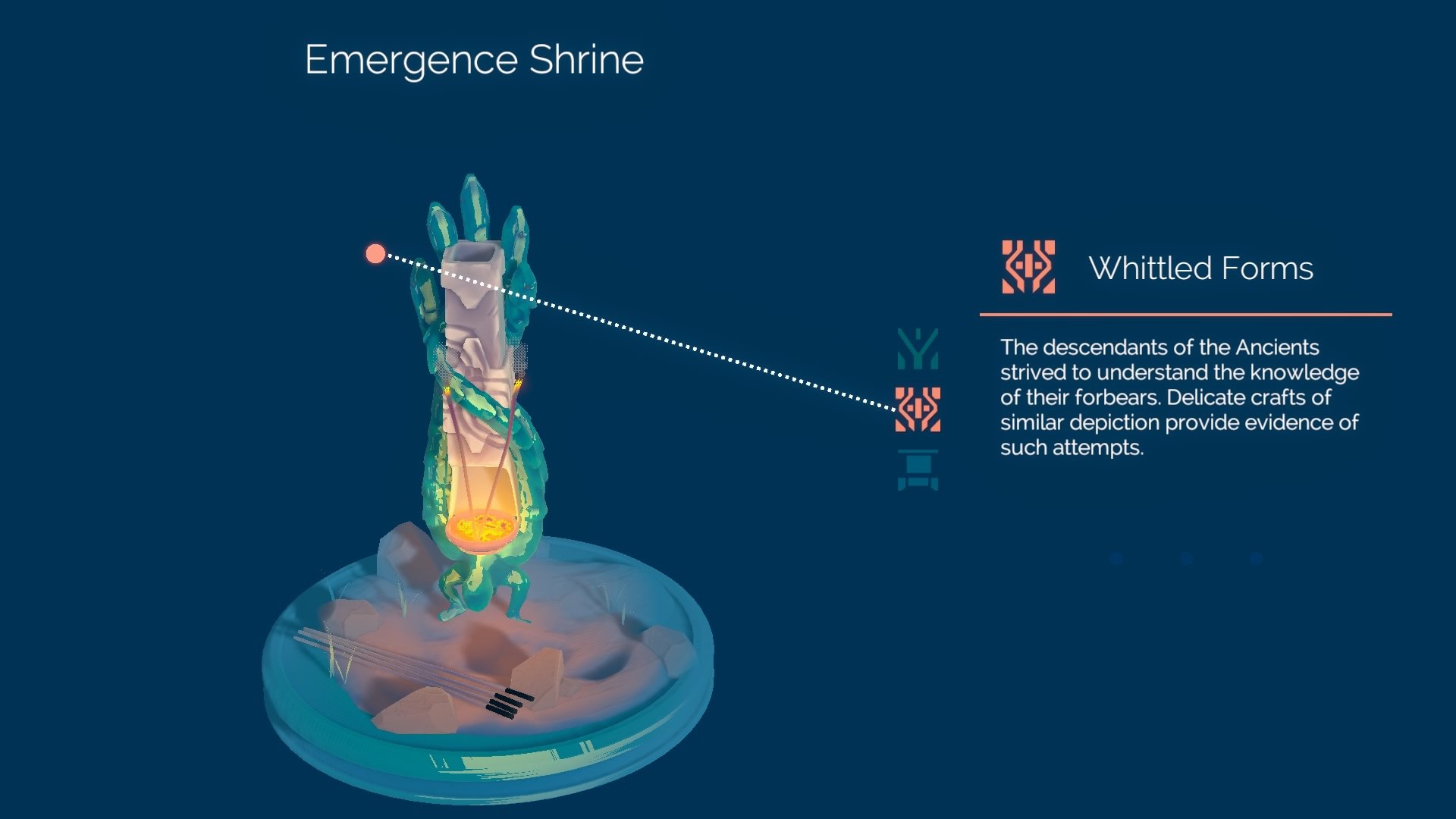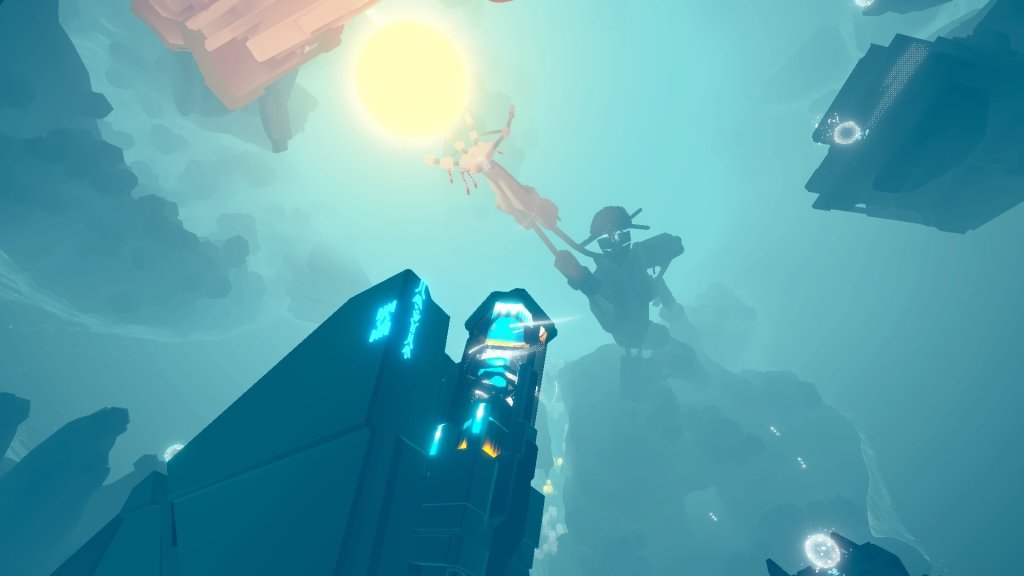It’s a rare pleasure when a title comes out of nowhere and blows me away. Here we are, only two weeks into 2018, and I’m pleased to say that I’ve played the best new game of the year so far. Relative newcomers, PolyKnight Games, have just released their freshman outing on consoles, the open-world adventure InnerSpace. Yet somehow, despite their documented lack of experience, this is an expedition you won’t want to miss.
Flying the Friendly Skies
InnerSpace doesn’t take long to place players at the yoke of oddly constructed glider, set adrift on the breezes of an extravagantly designed ecosystem named Inverse. Almost immediately, an unidentified submarine grabs focus and begins spewing an odd narrative about being some sort of a research vessel, in search of the secrets of this oddly constructed world. In short order, the player’s glider has somehow been drafted into active duty, acting as the cartographer for the sea-tethered counterpart’s misguided quest for knowledge.
As much as the narrative tries to explain all of the odd shenanigans going on throughout, it ultimately is superfluous at best. All that players really need to know is they’re on the hunt for random artifacts that are scattered about the environment. Over the course of the expedition, the game organically begins to explain the ship’s capabilities through subtle on-screen prompts. Some of the key abilities uncovered include being able to dive underwater and charging up the engine to release a quick burst of speed.
Early on, the search for hidden items provides a healthy enough challenge and plenty motivation to explore the world’s nooks and crannies. Only later does it become more apparent that things aren’t always as they appear. New environmental objects such as breakable walls, cords that can be flown through and cut, and random switches strewn haphazardly around the world, eventually become the primary mechanisms to unlock the secrets of each playable hub. Once a majority of the secrets have been uncovered, a warp is unlocked to the next hub.
[imagebrowser id=5885]
The Grass is Always Greener…
Easily the most exciting aspect of exploration is uncovering what’s on the other side of a warp gate. Each hub is so drastically different from what preceded it that it’s hard to imagine that they’re in a shared universe. To put it bluntly, InnerSpace’s Art Director deserves a goddamn medal. Despite being a compelling amalgamation of the familiar styles found in Flower, No Man’s Sky, and Journey (among many others), it still manages to stand on its own and feel like something truly original. The melding of organic, plant-like structures with the omnipresent sterile, yet complex technology, is further complimented by a mystical influence that imposes itself more prominently as the campaign progresses. The use of cel-shaded textures and vibrantly contrasting colors introduce variety to the environments and effectively provide subtle navigational suggestions to the player. These are both standout reasons why the game is so aesthetically pleasing and overwhelmingly approachable.
Admittedly, I’m a fan of artistically driven titles that continually tap into my inner explorer. Once I parted ways with the initial narrative soup, the surprisingly expansive hubs proved to be a siren’s call that I couldn’t turn down. The sense of wonderment and joy derived from simply exploring, left me giddy in anticipation of what I would find next. Around one corner you could uncover an ornately detailed shine, paying tribute to that hub’s specific deity. Other times, you could be flying down minimalistic tunnels in search of the next puzzle or challenge. But regardless of what the player expects at any given moment, once an objective has been completed, it’s hard to beat the anticipation of finding out what’s coming next.
In order to really sink your teeth into the meat of InnerSpace, however, you’ll need to slay its initially unwieldy control scheme. All navigation along the x and y axis are mapped to the left stick, while the rotation and throttle are mapped to the right stick. Especially during chase sequences found late in the campaign, it becomes extremely easy for the throttle controls to be off-center just enough to pitch the ship into an uncontrollable corkscrew. Over time these tendencies seem to be less of a factor, but once it becomes more difficult to navigate through the litany of tight corridors, this issue will most likely rear its ugly head again. For this reason, proper ship selection is critical. Each vessel has its own benefits and competencies, which if exploited correctly, can make the difference between total success and abject failure

Intermittent Turbulence
Despite being an experience that I eagerly devoured like a rabid wolverine, the game isn’t without its faults. For one, until the player has completed the first handful of environmental challenges, the momentum feels a bit directionless. You’ll eventually stumble into the exploratory mechanics organically, but it takes a bit too long to get to that point. Also, as was alluded to earlier, the overall narrative feels both uninteresting and unnecessary. In an era where games like Journey and Flower can tell a sweeping narrative without using a single line of dialog, I feel like InnerSpace could have pulled off a similar approach, while not detracting from the overall experience. Hell, the subtlety of leaving the storyline up to interpretation might actually add something to the experience.
My last, and easily most substantial pet peeve is related to level resets, triggered through excessively and continuously grinding a ship against a solid object. Once this has gone on for long enough, the player is either reset to the most recent checkpoint, or in most cases, taken back to the beginning of the entire level. On the surface this seems like an innocuous way to handle a technical glitch like getting stuck in the geometry. However, once the environmental puzzles begin to ramp up in difficulty, this “helpful” reset mechanic is actually used against the player. There’s nothing more irritating than inadvertently rubbing up against a wall for too long while attempting to double back and flip a switch, only to be suddenly warped back to hub entrance. Not cool, InnerSpace. Not cool at all.
Before wrapping up, I’d be remiss if I didn’t show some love to the game’s soundtrack. It does a fantastic job of augmenting the moment-to-moment gameplay. The closer a ship gets to an artifact or key environmental obstacle, the more the music creeps into the foreground. Each stage is in its own musical key that helps define the overall tone and continuously adds layers of complexity as it nears completion. The score isn’t bombastic enough to stand on its own, but as they say, “sometimes less is more.”
In case you couldn’t tell, InnerSpace is a game that you should be playing. The well-realized worlds, exceptional aesthetic and compelling exploration mechanics complement each other tremendously well. If you can get past the occasional bout of unnecessary complex exposition, the evolution of each environment tells a compelling enough story to keep you enthralled from start to finish. Drop everything and check out what deserves to be one of the sleeper hits of 2018.
InnerSpace review code provided by publisher. Version 1.0 reviewed on a standard PlayStation 4. For more information on scoring please see our Review Policy here.
-
Amazing art direction
-
Interesting hubs worth exploring
-
Always something new to discover
-
A vibrantly well-realized world
-
The control scheme takes some getting used to
-
Narrative doesn't seem necessary








